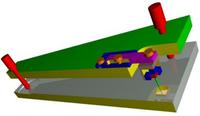| Build Your Own Scanning Tunneling Microscope | 2004-01-04 11:05 7 comments |
 by Flemming Funch by Flemming FunchA group at University of Münster in Germany are giving away the complete DIY plans for building your own Scanning Tunneling Microscope. That would be a key piece if you plan on experimenting with nanotech in your garage. The interesting part is that this is open source technology. Here's part of their license: We grant everybody the right to construct the microscope using the here-published design for private or educational purposes. On these web pages all necessary diagrams, drawings, material descriptions and software-source-codes are published for free access. While granting the right to build the microscope we make it mandatory that new developments, improvements or other applications of our design are also made openly available for private or educational purposes. |